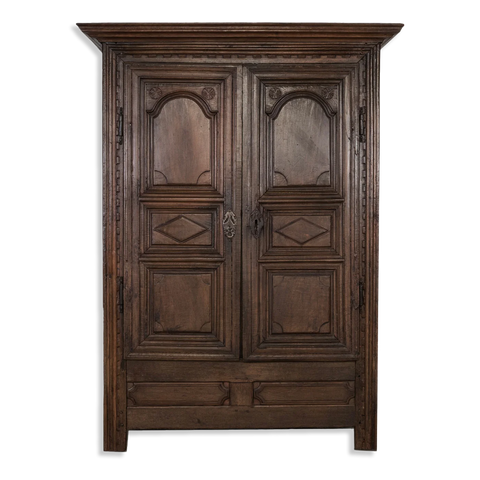1. Meet the French Royal Style: Louis XIII
Louis XIII was the king of France from 1610 to 1643, climbing the throne at the age of only 8 years old. He was known as Le Juste, the Fair. Louis XIII was the first king to wear a wig, solely inspiring the trend of male wig wearers. This trend is still present in court rooms today. His friendship with his chief ministers, Charles d’Albert and Cardinal Richelieu, would inspire Alexandre Dumas to write his famous novel The Three Musketeers. The favourite instrument of Louis XIII was the lute, which he could play by the age of 3!
Louis XIII Furniture style
The Louis XIII furniture style, is characterized by its solid and robust design. First influenced by the neighbouring countries, especially Flanders and Spain, and drawing inspiration from the Renaissance style, the Louis XIII style develops to become the first full French style. It gives a lot of space for woodturning and carving. Seats and tables, mostly made in walnut, show richly turned beaded, twist or baluster legs. Mouldings are usually very deep: we often see the diamond-shaped design or the Maltese cross.
Louis XIII Furniture style
The Louis XIII furniture style, is characterized by its solid and robust design. First influenced by the neighbouring countries, especially Flanders and Spain, and drawing inspiration from the Renaissance style, the Louis XIII style develops to become the first full French style. It gives a lot of space for woodturning and carving. Seats and tables, mostly made in walnut, show richly turned beaded, twist or baluster legs. Mouldings are usually very deep: we often see the diamond-shaped design or the Maltese cross.
The predominant wood used in Louis XIII furniture was oak. Louis XIII furniture favoured rectilinear forms with straight lines and geometric shapes. The emphasis was on simplicity and symmetry. Carved embellishments were a distinctive feature of Louis XIII furniture. While not as intricate as later styles, pieces displayed mostly geometric carvings. Cabinets and storage pieces often had paneled doors and drawers. Hardware, such as iron pulls and escutcheons, was simple and functional. Upholstered furniture was characterized by simple upholstery with minimal decoration.


Lack of Ornate Gilding
Unlike later French furniture styles, Louis XIII furniture generally lacked extensive gilding. The focus was on the natural beauty of the wood and carved details.
The Louis XIII Furniture style, rooted in practicality and strength, laid the foundation for subsequent French furniture styles. Its emphasis on architectural elements and sturdy construction contributed to the evolution of furniture design in the 17th century.


Lack of Ornate Gilding
Unlike later French furniture styles, Louis XIII furniture generally lacked extensive gilding. The focus was on the natural beauty of the wood and carved details.
The Louis XIII Furniture style, rooted in practicality and strength, laid the foundation for subsequent French furniture styles. Its emphasis on architectural elements and sturdy construction contributed to the evolution of furniture design in the 17th century.










